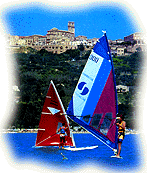 |

|
|
THE SEA |
|
| The most spectacular transformation of the Abruzzo landscape that has taken place in the period between the 19th century and the present day is without a doubt the one involving the coast. Since then, tourism has been one of the essential stimuli in the transformation of the Abruzzo coastline. A deep beach of golden sand 140 kilometres long welcomes visitors from the North to Abruzzo: Alba Adriatica, Villarosa and Martinsicuro join forces to form a seaside metropolis, a blue city. There is a huge sandy beach, still unpolluted; in town there are 65 comfortable hotels, discos, dance halls, bars, pizzerie. In summer, it is only a short distance away from the international sports events of the Interamnia Cup (volleyball) at Teramo, a city with the artistic and gastronomic traditions. Close by, Tortoreto and Giulianova confirm not only their beauty but also their gastronomic reputation for seafoods, and offer modern hotels and several well-equipped camping sites. There is plenty of entertainment for young people in the evening, but a quiet life is guaranteed for those who seek it among pine-woods and villas with the scent of oleanders. Nature has been generous at Pineto, Roseto and Silvi: the very place names conjure up an idea of pleasant perfumes. The three bathing resorts can boast shady beaches with Mediterranean maquis and huge pine-woods reaching all the way down to the sands. There are a great many hotels, camping sites and pensions. From all the towns on the coast visitors can make excursions or trips inland, to visit the many artistic centres: Atri, Campli, Castelli, Penne, the Gran Sasso or the Abruzzo National Park, L'Aquila or Sulmona. The beaches in Abruzzo, especially in the province of Teramo, maintain their own style, a way of life: no crowds, no stalls in the streets, no noise.On the other hand there are a number of fine shows or concerts. From Montesilvano to Pescara, with about twenty kilometres of broad sandy Adriatic beach, is the "metropolis" of Abruzzo, which developed quickly after 1960. Half a million visitors to the coast every year, lots of hotels and camping sites by the sea, and a huge number of pensions and villas to rent. You can even sleep under the stars in D'Annunzio's pine-wood at Pescara. Broad, serene, lively and cordial, the urban belt between Pescara and Montesilvano is bright and sunny; the people are good-natured and hospitable without being obsequious. The town of D'Annunzio and Flaiano also offers culture: jazz, theatre, art, cabaret, music. For those in search of enjoyment there are first-rate cinemas, top-division sports, swimming pools, variety shows, fifteen or so smart night clubs and many open-air restaurants and bars (the ice-cream is realy exquisite) where you can sit up till the small hours without noticing it, along with Pescara's free and easy young people. There are many shops in the commercial centre, some of them most attractive. A few steps farther South, D'Annunzio and Michetti used to sunbathe on the shores of the Adriatic. Pescara has a brand-new tourist port, with berths for more than a thousand boats. The railway station is a modern building, one of the biggest in Europe. Flights from nearly all over Europe, from London to Moscow, land and take off from the whole of Abruzzo, thanks also to the magnificent motorway tunnel of the Gran Sasso, cut through a wall of sheer rock 1000 metres high. Francavilla, a town of splendid villas overlooking the sea, palm trees and quiet avenues, is the doorway to the sunny South, scented with broom and spices. Before we reach Molise, the seascapes assume a fascinating harshness, dear to poets and writers. With a few rocks and old fishing nets, the gentle serene beaches of Fossacesia, Ortona and San Vito lie amid greenhouses and orchards, olive-groves and vineyards with exquisite juice, tobacco fields, eucalyptus trees and sea pines. There are excellent tourist facilities, some very good restaurants, and splendid buildings at Lanciano and in the inland centres. For tourists with religious interests, the Church of St.Francis at Lanciano must not be missed. It is the Sanctuary of the Miracle of the Eucharist. The tokens of the first Eucharistic Miracle recorded by the Church are kept in the high altar. The Maiella watches over the sea like a mother from its height of 2800 metres, this same sea where ships laden with cargo were already riding the waves as many as three thousand years ago. Lastly we come to Vasto, an incredibly pretty moonlit bay, making an unforgettable postcard with the August moon. Vasto is the home town of fish soups and, with Ortona, a port of departure for boat services to the Tremiti Islands.
|
||



